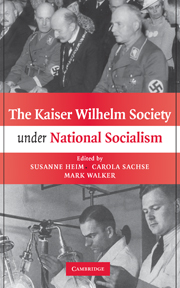Book contents
- Frontmatter
- Contents
- Tables
- Illustrations
- Editors
- Contributors
- Abbreviations
- Archives
- 1 The Kaiser Wilhelm Society under National Socialism
- SECTION I RESEARCH AND PERSONNEL POLICIES
- SECTION II RACIAL RESEARCH
- 5 Brain Research and the Murder of the Sick: The Kaiser Wilhelm Institute for Brain Research, 1937–1945
- 6 Two Hundred Blood Samples from Auschwitz: A Nobel Laureate and the Link to Auschwitz
- 7 Racial Purity, Stable Genes, and Sex Difference: Gender in the Making of Genetic Concepts by Richard Goldschmidt and Fritz Lenz, 1916 to 1936
- SECTION III EASTERN RESEARCH, LIVING SPACE, BREEDING RESEARCH
- SECTION IV MILITARY RESEARCH
- SECTION V THE POSTWAR “POLITICS OF THE PAST”
- Bibliography
- Index
6 - Two Hundred Blood Samples from Auschwitz: A Nobel Laureate and the Link to Auschwitz
Published online by Cambridge University Press: 29 July 2009
- Frontmatter
- Contents
- Tables
- Illustrations
- Editors
- Contributors
- Abbreviations
- Archives
- 1 The Kaiser Wilhelm Society under National Socialism
- SECTION I RESEARCH AND PERSONNEL POLICIES
- SECTION II RACIAL RESEARCH
- 5 Brain Research and the Murder of the Sick: The Kaiser Wilhelm Institute for Brain Research, 1937–1945
- 6 Two Hundred Blood Samples from Auschwitz: A Nobel Laureate and the Link to Auschwitz
- 7 Racial Purity, Stable Genes, and Sex Difference: Gender in the Making of Genetic Concepts by Richard Goldschmidt and Fritz Lenz, 1916 to 1936
- SECTION III EASTERN RESEARCH, LIVING SPACE, BREEDING RESEARCH
- SECTION IV MILITARY RESEARCH
- SECTION V THE POSTWAR “POLITICS OF THE PAST”
- Bibliography
- Index
Summary
As the 1939 Nobel Laureate and subsequent president of the Max Planck Society, Adolf Butenandt represented Germany's first-class research of his time like nobody else and received many honors during his lifetime. Yet, in recent years he has met increasingly with public criticism: he has been blamed for several things – in particular, his conduct during the National Socialist era. The most severe of these reproaches will be the issue of this essay: according to this charge, Butenandt had been at least aware of, if not actually involved in, the human experiments conducted by SS physician Josef Mengele in the Auschwitz death camp.
The first suggestion for a connection between Butenandt's institute and Auschwitz was detected by molecular biologist Benno Müller-Hill. This connection consisted in a project conducted by a colleague of Butenandt, the hereditary pathologist and physical anthropologist Otmar von Verschuer, for which he received blood samples that Mengele had acquired from Auschwitz. Müller-Hill then tried to reconstruct this venture. Though universally accepted, his reconstruction leaves some questions unanswered. Therefore, this chapter will first describe the key sources for the project so as to place this project and its personnel in historical context. Subsequently, Müller-Hill's reconstruction will be described and analyzed before an alternative reconstruction is introduced. Finally, some thoughts on the evaluation of this project will be offered.
- Type
- Chapter
- Information
- The Kaiser Wilhelm Society under National Socialism , pp. 120 - 144Publisher: Cambridge University PressPrint publication year: 2009
- 3
- Cited by

